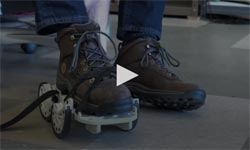Stroke patients relearning how to walk with peculiar shoe

The iStride device is strapped over the shoe of the good leg and generates a backwards motion, exaggerating the existing step, making it harder to walk while wearing the shoe. The awkward movement strengthens the stroke-impacted leg, allowing gait to become more symmetrical once the shoe is removed. Credit: University of South Florida
Stroke sufferers experience muscle weakness or partial paralysis on one side of the body, which greatly impacts how they walk, known as gait. Gait asymmetry is associated with poor balance, a major cause of degenerative issues that make individuals more susceptible to falls and injuries.
The iStride device is strapped over the shoe of the good leg and generates a backwards motion, exaggerating the existing step, making it harder to walk while wearing the shoe.
The awkward movement strengthens the stroke-impacted leg, allowing gait to become more symmetrical once the shoe is removed. The impaired foot wears a matching shoe that remains stationary.
“The backward motion of the shoe is generated passively by redirecting the wearer's downward force during stance phase. Since the motion is generated by the wearer's force, the person is in control, which allows easier adaptation to the motion,” said developer Kyle Reed, PhD, associate professor of mechanical engineering at the University of South Florida.
“Unlike many of the existing gait rehabilitation devices, this device is passive, portable, wearable and does not require any external energy.”
The trial included six people between ages 57 and 74 who suffered a cerebral stroke at least one-year prior to the study. They all had asymmetry large enough to impact their walking ability. Each received twelve, 30-minute gait training sessions for four weeks.
With guidance from a physical therapist, the patients' gait symmetry and functional walking were measured using the ProtoKinetics Zeno Walkway system.
All participants improved their gait's symmetry and speed. That includes how long it takes to stand up from a sitting position and walk, as well as how long it takes to walk to a specific location and distance traveled within six minutes. Four improved the percentage of time spent in a gait cycle with both feet simultaneously planted on the ground, known as double limb support.
As far as the other two that didn't improve, one started the study with severe impairment, while the other was highly functional. It's also important to note that three participants joined the study limited to walking in their homes. Following the trial, two of them could successfully navigate public venues.
Reed compared his method to a previous study conducted on split-belt treadmill training (SBT), which is commonly used by physical therapists to help stroke patients improve their gait. The equipment allows the legs to move at different speeds, forcing the patient to compensate in order to remain on the treadmill. While the SBT improves certain aspects of gait, unlike the iStride, it doesn't strengthen double limb support.
That research concluded only about 60 percent of patients trained on the SBT corrected their gait when walking in a normal environment. Walking is context dependent where visual cues impact how quickly one tries to move, and in what direction. The iStride allows patients to adjust accordingly. Movement on a treadmill is predictable and provides individuals a static scene.
Since patients are often disappointed in their progress after being discharged from rehabilitation, the iStride's portability allows patients to relearn to walk in a typical setting more often and for a longer duration. Reed is now working on a home-based clinical trial with 21 participants and expects to publish results within the next year.
He recently received a Fulbright scholarship to conduct research at Hong Kong Polytechnic University. He's working in the rehabilitation sciences and biomedical engineering departments throughout the 2019-2020 academic year.
Media Contact
More Information:
http://dx.doi.org/10.1186/s12984-019-0569-xAll latest news from the category: Innovative Products
Newest articles

Durable, Efficient, Sustainable: The Rise of Cerium Oxide Thermal Switches
Groundbreaking cerium oxide-based thermal switches achieve remarkable performance, transforming heat flow control with sustainable and efficient technology. Cerium Oxide-Based Thermal Switches Revolutionize Heat Flow Control Thermal switches, which electrically control…

How Industrial Robots are Reducing Emissions in Global Manufacturing
A new study explores the intersection of industrial automation and environmental sustainability, focusing on the role of industrial robots in reducing the carbon intensity of manufacturing exports. The research demonstrates…

Patients Can Heal Through Precise, Personalized Bioceramic Grafts
A recent review is transforming the landscape of craniomaxillofacial bone regeneration with the introduction of personalized bioceramic grafts. This pioneering research explores the fabrication and clinical potential of synthetic grafts…



